
Physical Fitness - English I and English II - Grades 9-12
- Subject:
- English Language Arts
- Material Type:
- Assessment
- Date Added:
- 07/18/2022

Physical Fitness - English I and English II - Grades 9-12
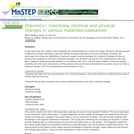
This activity is a classroom lab where students observe and classify chemical and physical changes using the five characteristics of a chemical change, interpret their findings, and use evidence to support their findings.
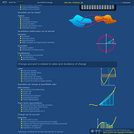
The purpose of this video tutorial is to review a couple ways in which we think about numbers. Thinking in terms of street numbers, money in bank accounts, and quantum particles (e.g. Bose-Einstein condensate) is contrasted with focusing on associating numbers with distinguishable manipulatives, as is more familiar in K-8 courses. This video concludes with a reminder that the symbol "infinity" is not, itself, a number.

Short Description:
This lab manual is a cross-institutional project from British Columbia (BC), Canada that provides 24 labs to be implemented within first year post-secondary physical geography courses. The labs have been developed to be easily adapted for various course structures, durations, and differing laboratory learning objectives set out by instructors. Instructor notes are available for each lab that outline the instructional intent of the lab author, along with some suggestions for modifications. The lab manual is licenced under a creative common license (refer to licensing information) so that the lab modules can be modified as needed. The second edition of this lab manual was created for the onset of the 2021/22 academic year.
Long Description:
Physical geography lab exercises tend to be crafted for internal institutional use only. In light of the need to have online laboratory material for remote instruction, a group of geography instructors from across British Columbia (BC), Canada came together for this collaborative project with the goal of producing a cross-institutional open education resource (OER) laboratory manual for first-year post-secondary physical geography courses. The lab manual consists of 24 labs that cover an introduction to physical geography, weather and climate, biogeography, map and geospatial skills, hydrology, geomorphology, and landform identification. Many of the labs have a BC setting; however, they are useable across Canada and further abroad. The majority of the labs have been developed so that they can be done in any order to increase instructor flexibility and promote adaptability to differing course structures and durations. Many of the labs have students using live data, or built-in flexibility with datasets for instructors in order to prevent the lab exercises becoming static over time. The lab manual is licenced under a creative common license (refer to licensing information) so that the lab modules can be modified as needed by instructors to meet the learning outcomes of their students.
The second edition of this lab manual was created in the spring and summer of 2021 for the 2021/22 academic year and beyond. The second edition features substantial revisions to the labs and instructor notes for consistency and effectiveness, a reordering of the lab numbers, and two new labs (lab 07 and 19).
Word Count: 104364
ISBN: 978-1-77420-209-8
(Note: This resource's metadata has been created automatically by reformatting and/or combining the information that the author initially provided as part of a bulk import process.)
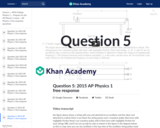
Fundamental frequencies (first harmonics) of strings.
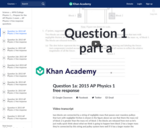
Free body diagram for two masses connected by string-pulley system.

Acceleration of two masses connected by string-pulley system.
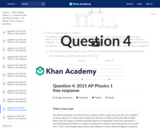
Identical spheres falling from the same height with different horizontal velocities.
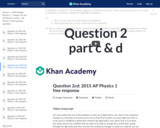
Testing if a bulb is nonohmic.
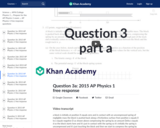
Graphing energy versus position for a block accelerated by a spring and stopped by friction.
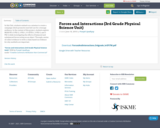
In this Unit, students embark on a mission to create a campaign which promotes seat belt use for a teenage audience. In the context of this project, students explore NGSS PE’s 3-PS2-2, 3-PS2-1, 3-5-ETS1-1, 3-PS2-3, and 3-PS2-4 while investigating the effects of balanced and unbalanced forces acting on an object. Through a series of collect evidence to write a claim based on evidence for why seatbelts are important.

My personal notes for Solid State Physics (PH 461) at Southern Oregon University.Dr. Ellen Siem

Word Count: 25130
(Note: This resource's metadata has been created automatically by reformatting and/or combining the information that the author initially provided as part of a bulk import process.)
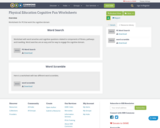
Worksheets for PE that work the cognitive domain
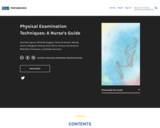
This open access textbook is an introductory resource to guide best practices of objective assessment techniques related to inspection, palpation, percussion, and auscultation (IPPA). Its intended audience is students in health-related post-secondary programs such as nursing.

Ultrasound has a wide range of medical applications. Some of these include obstetrics (monitoring the progress of pregnancy), oncology (monitoring the growth of tumors), cardiology (visualizing the heart function and physiology), biopsy (guiding needles in various procedures), and physiotherapy. For example, today, an estimated 60-70% of pregnant women in the United States undergo ultrasound examination during pregnancy. An estimated 250 million fetal ultrasound examinations are performed every year in the USA. In the last few decades, ultrasound technology has expanded to medical imaging in various other specialties: Anesthesiology, Critical Care, Emergency Medicine, General Pediatrics, Internal Medicine, Obstetrics and Gynecology (OB-GYN), Pediatric Emergency Medicine, Physiatry, Sports Medicine, and Surgery. The increasing demand in the use of ultrasound technology in various biomedical fields points to a future in which medical professionals will be required to possess a general knowledge of ultrasound technology. While currently most medical professionals rely on technicians to perform the imaging studies, there can be a high degree of operator dependent results. Therefore, a solid foundation of the technological properties of ultrasound would give health care providers a competitive advantage in the future. This is one of the first goals of this textbook. This textbook also covers general aspects of diagnostic ultrasound providing an excellent reference for both beginners and professionals. In addition, this textbook has end-of-the-chapter experiments that will help educators conduct labs for students and any other learners to enhance their learning and solidify the practical skills.
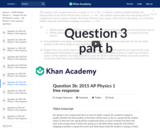
How doubling spring compression impacts stopping distance.
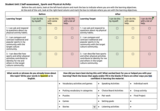
This OER Student self- assessment was created by Liz Martinez, Kelleen RoseBaugh, and Chloé Reinwald and as part of the 2024 World Language OER Summer work and training. Educators worked with Chrystal Liu, Nick Ziegler and Dorann Avey to create OER Learning Plans and materials. The attached self-assessment is designed for 9 - 12 World Language Arts teachers for Novice Learners of Spanish. Students will use the same self-assessment assignment at the beginning and end of the Unit This self-assessment addresses the following NDE World Language Standard(s): NE.WL.3.1.C NE.WL.3.1.D NE.WL.5.1.C NE.WL.5.1.D NE.WL.5.2.C NE.WL.5.2.D It is expected that this self-assessment will take students 10-20 minutes to complete.
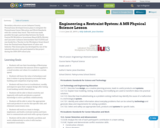
Secondary educators across Lebanon County, Pennsylvania developed lesson plans to integrate the Pennsylvania Career Education and Work Standards with the content they teach. This work was made possible through a partnership between the South Central PA Workforce Investment Board (SCPa Works) and Lancaster-Lebanon Intermediate Unit 13 (IU13) and was funded by a Teacher in the Workplace Grant Award from the Pennsylvania Department of Labor and Industry. This lesson plan was developed by one of the talented educators who participated in this project during the 2018-2019 school year.
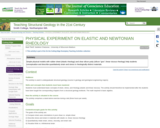
To prepare for the activity, students do background reading on rheology from structural geology textbook. In the lab, students are provided with the required analogue model materials (rubber sheets attached to aluminum grips, silicon goo, and straw). Their task is to apply specific type of deformations on the materials, make measurements, and calculate properties of the deformation.
(Note: this resource was added to OER Commons as part of a batch upload of over 2,200 records. If you notice an issue with the quality of the metadata, please let us know by using the 'report' button and we will flag it for consideration.)